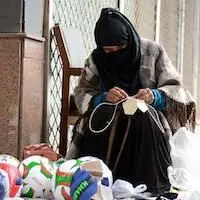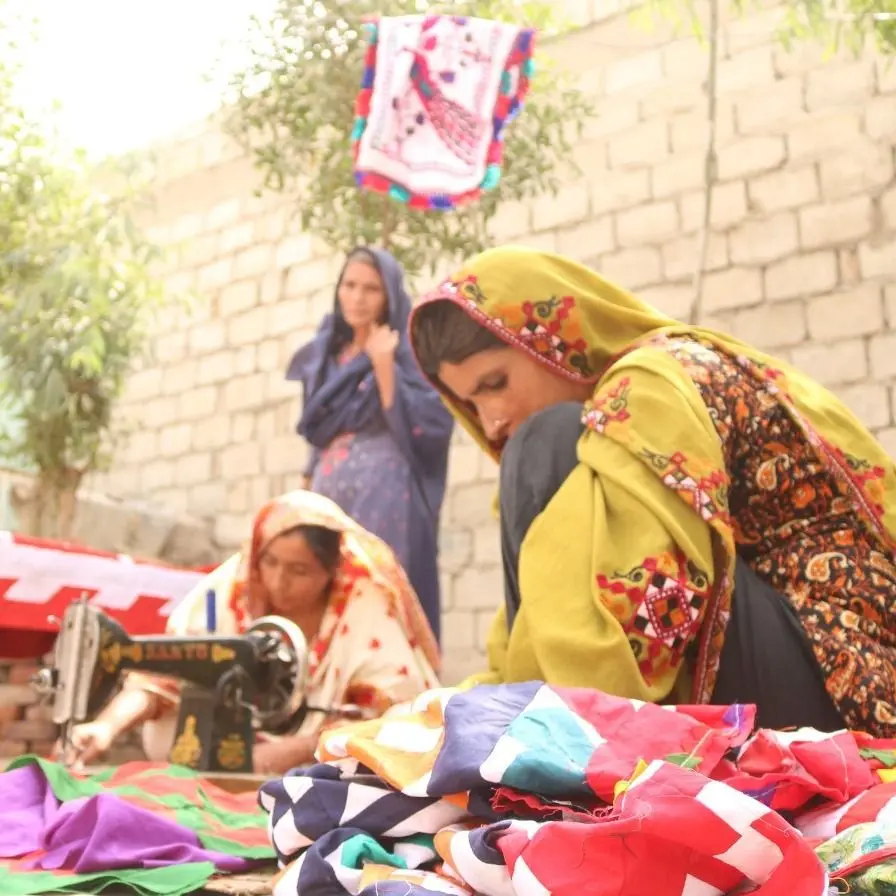THE cottage and small-scale industries have a vital role in income and employment generation. They are a tool for the reduction of poverty. Handicrafts preserve and promote cultural and artistic traditions. However, this industry is facing serious setbacks. According to Siddiqa Malik, chairperson of the Indus Heritage Trust (IHT), “The artisans are finding it extremely difficult to make ends meet and some of them have even started to abandon their crafts.” It is necessary to implement a sustainable program to help these artisans and to safeguard the national and cultural heritage which is represented by these crafts.

Abida Bibi stitching a handmade football on the streets of Islamabad
There are a number of underlying factors which have accelerated the trend in the demise of handicrafts in Pakistan and other developing countries. Poor infrastructure presents a problem to handicraft entrepreneurs in rural areas. The power supply is inadequate which makes it hard to finish products on time. Frequent power breakdowns and fluctuations in voltage cause damage to machines. Roads are often under developed which makes it hard for artisans to obtain and transport raw material and increases production costs.
Artisans often lack access to mainstream markets. They don’t have access or contacts with suppliers of raw materials, as they deal mainly with middlemen. This puts them at a disadvantage as it is important to know various suppliers in order to negotiate the most appropriate price and quality. These artisans have limited marketing and export avenues and linkages. They lack access to foreign markets and rely on local melas or exhibitions, which are also lacking in number.
Artisans are trapped in a perpetual cycle of exploitation by middlemen. Due to lack of access to markets, they rely on middlemen to sell their products. However, they are paid very less by them and according to the number of pieces they produce. Middlemen sell the goods they produce at very high prices and accumulate huge profits. They keep almost ninety percent or more of the profits generated through these sales. Also, as customers contact middlemen, artisans are left behind the lens. They are unable to build a loyal customer base and do not know how to approach and retain customers. This makes it difficult for them to branch out on their own.

Ameeran Bibi, a home based working woman, has to face numerous challenges while making handmade Sindhi Rillis
Artisans are faced with acute financial shortages which make it hard for them to acquire equipment and raw material of the requisite quality. They are unable to give export quality finish to their products according to international market standards. It is also difficult for them to expand their business as they cannot get loans from local banks. This is because they cannot guarantee re-payment. Also, their profit margins are very low to cover the interest rates and are spent on their daily expenses. This leaves them with limited capital to expand their industrial units. The behavior of government departments and the bureaucracy has also not been very encouraging. As these artisans lack exposure, they are not aware of the worth of their own craftsmanship. They don’t know how to stand on their own feet and market their products, which leaves them vulnerable.
Industrialization and globalization has negatively affected artisans. They are facing increasing competition from mills, power looms and organized units. As they are unable to compete with industries, they are forced to sell their goods at reduced prices. Industrialization has changed the lifestyles and needs of people which has resulted in handicrafts losing their demand and importance. As industrial products become more sophisticated, handicrafts lose their value and artisans go out of business. This is threatening the extinction of several crafting techniques. Products are becoming commoditized and replaced by machine made items. Plastic sandals are replacing leather ones and displacing leather shoemakers. Handicrafts are being replaced by mass produced items as these are cheaper and sellers have high production capacity with strong logistical support. Economies of scale are not available to artisans and production costs are higher. Goods produced in small scale industries cannot compete in open market if the same goods were manufactured on a large scale. Pakistani artisans are also facing increasing competition from imported Chinese products which are cheaper and of better quality.
Shortage of water leads to low production and quality of Ajraks made by artisans in Sindh
There is a lack of availability of sufficient data for the handicrafts industry in most developing countries. As it is part of the informal sector, not much statistical information is available. This makes it hard for policymakers to formulate proper policies for the safeguarding of artisans. As a result, it is becoming harder to promote and revive this sector. Also, the younger generation is unwilling to continue the profession of their ancestors. They prefer to do less demanding work in factories with higher pay.
Artisans lack innovation in designs. They don’t have sufficient knowledge of modern designs which can be marketed easily. As a result, they are unable to meet the changing requirements of customers. If they develop new products, they are unable to face the risks of patents and copyrights. They are also not equipped with modern technologies and work using traditional equipment. There is a dire need for artisans to merge traditional crafts with modern designs in order to remain competitive. Most artisans are rural based so they lack access to internet services and smart phones and are not digitally connected. This makes them unable to connect to local and international markets. They are selling their products in traditional ways like exhibitions and are losing out on the opportunities provided by e-Commerce.
There is a lack of education and training facilities for artisans. Children often miss out on school as making most handicrafts requires a lengthy and complex process. This makes it difficult for artisans to access various government schemes, obtain market information, bargain with middlemen/traders and manage their business properly. They become uncompetitive as a result. This is often the case with home based women workers. There are not many vocational training schools in developing countries like Pakistan. These artisans learn their craft from their elders and are often lacking in technical or advanced training.
